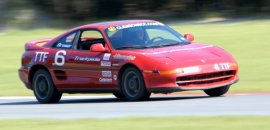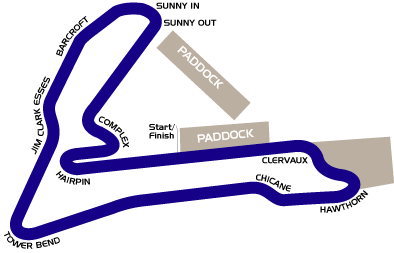CroftFrom Trackpedia
Track SummaryWeb site http://www.croftcircuit.co.uk/ Address: Croft Circuit, Croft on Tees, North Yorkshire, DL2 2PN Google Maps Address: Croft-on-Tees, England Typical Lap Times
Track MapWeather ForecastIntroductionRacing at Croft can be traced back as far as the 1920s, when cars were in their infancy. But it was World War II which signified Croft's partnership with automata. As part of a compulsory land order by the government and because of Croft's unique vantage point in terms of air travel (follow the Tees, then turn left) 160 acres of farm land was commissioned as a relief landing ground for nearby Middleton St George. Drainage and runways were quickly laid and temporary barracks erected - though not quickly enough, before work was completed troops of the Canadian Royal Air Force arrived. And so in September 1942 Croft's association with the Maple leaf commenced and was to remain until the end of the war. The 419 (Moose) Squadron arrived at the hastily built air base. For the next three years, Croft became home to Wellington, Lancaster, Whitely, Stirling and Halifax bombers, which played an important role in the raids on Germany. otor sport enthusiast, Bruce Ropner, rallied some of his fellow racing fans together with the idea of building his very own motor racing venue. He and his companions managed to acquire half the airfield in a public auction in 1962. After about 18 months he was granted permission to build his own race circuit, which was completed in July 1964. "I then had the pleasure of driving my own XK150 around a real circuit," says Mr Ropner. "Of which I was part owner." Crowds estimated at the time as anything from 30,000 to 50,000 strong, flocked to the circuit on August Bank Holiday Monday, 3rd August 1964 for it's first meeting. It was Liverpool saloon car driver, Robin Smith (driving a Lotus Cortina) who won the Daily Mirror Trophy, kick starting Croft's career in national motor sport. Several drivers racing in that opening programme went on to become firm favourites with the Croft crowds. Tony Dean, then a novice with an F3 Lotus 31, progressed successfully to international sports car racing, Canam and F5000 and often ran at Croft with a mouth-watering succession of Porsche, Ferrari, Brabham, McLaren and Chevron exotics. As trackside facilities were added - who can forget Croft's converted lorry 'control tower' - and drivers from further afield came to appreciate the qualities of the demanding, fast, 1.64 mile circuit, national and international meetings were staged on a regular basis. By 1970 the then Guards International Trophy catered for the frantically close F3 racing of the time, with victory falling to future Brabham Grand Prix winner Carlos Pace. The following year, future world champion, James Hunt was in the running. His next visit to Croft, however, was as a VIP guest. As the 1970s wore on, Croft faced increasingly strong competition from circuits in the south, as Brands Hatch and Silverstone strengthened their grasp on Britain's leading international events Croft stagnated. Nevertheless many seasons of club and national championship racing continued with BARC, BRSCC, DDMC and Nottingham Sports Car Club organising meetings. Basic facilities did not deter devoted motor sport drivers and enthusiasts. Current World Formula One champion, Damon Hill, who cut his racing teeth on motorcycles before launching his successfully F1 career, was a familiar face at Croft. As were Barry Sheene and Nikki Lauda, who enjoyed the circuit's variety and interesting design. In 1981, Croft retired from tarmac racing in favour of the increasingly popular sport of Rallycross. Former British and European Champion Will Gollop says: "The loose surface was vital to a good Rallycross track and it was always very good at Croft. The track was staggeringly quick and needed a lot of concentration." With a growing reputation, Croft began to look towards international events. In November 1987 the FIA Inter -Nations Cup meeting came to Croft and was heralded, by the 10,000 or so there, as one of the best Rallycross events ever staged in Britain. Less than three years later the event returned to Croft and this time boasted an even greater entry as the mighty Norwegian squad - missing in '87 - made their debut. From there it was onwards and upwards for Croft, hosting the British Round of the FIA European Championship. And in June of 1994 the cream of Europe returned to Croft and fought for ERC points. More than 10,000 spectators cheered as they were treated to great action as Britons made it on the podium in all three classes - winning two of them. Media attention was higher than at any time before. So the decision by the current circuit owner, was made for Croft to return to tarmac racing. With the renaissance of Croft in 1995, the circuit picked up much where it left off, with some well-supported club-level meetings for cars and motorcycles but the circuit needed to host higher profile events, and sights were set on the British Touring Car Championship In 1997 the circuit underwent a major transformation - extending the circuit to 2.127 miles - sixty per cent of the new circuit is built on old runways, with foundations and drainage already in place- constructing a control tower, pit and paddock complex and landscaping new trackside spectator area.. The £1.5 million investment heralded the return of top class motor sport in the North East, a new beginning in Croft's chequered history. Track GuideThe follow sections describe the turns or series of turns on the race track in a step by step detail from various people who have driven the track Turn by turn guide to the Croft Circuit track Motorcycle turn by turn guide to the Croft Circuit track GPS Track Map and Vehicle DynamicsComing soon VideoVideo of Croft in classic Lotus Elise More videos from the web
|

